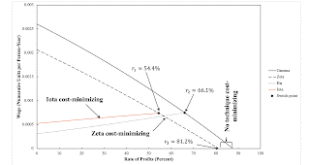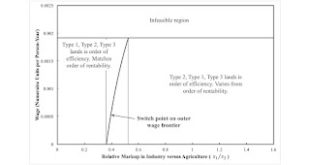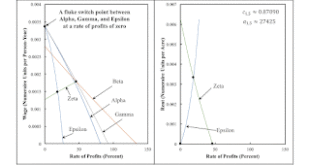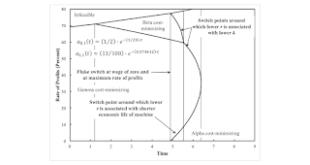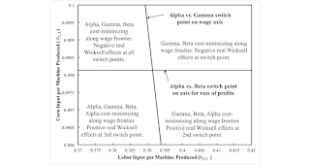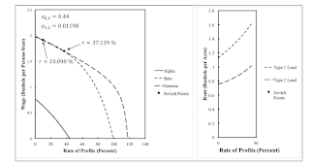Figure 1: Wages Curves for Example of Intensive Rent1.0 Introduction This post modifies an example from Antonio D'Agata. Two types of land exist, each specialized for producing a specific commodity. In the example, some wage curves slope upwards, which is not possible in a model with circulating capital alone. The cost-minimizing technique is not found from the outer frontier of the wage curves. For one range of the rate of profits, no cost-minizing technique exists, even though a...
Read More »To Do: Perverse Switch Points And The Economic Life Of A Machine
Table 1: Lower Rate of Profits Around A Switch Point Traditional Marginalist Story'Perverse' Marginalist StoryTraditional Austrian StoryNegative real Wicksell effect, greater net output per workerPositive real Wicksell effect, smaller net output per workerLonger economic life of machineLonger economic life of machine'Perverse' Austrian StoryNegative real Wicksell effect, greater net output per workerPositive real Wicksell effect, smaller net output per workerShorter economic life of...
Read More »Variations in the Economic Life of Machines
These posts demonstrate, in a model of fixed capital, that the cost-minimizing choice of the economic life of a machine need not conform to traditional Austrian and marginalist theory. The cost-minimizing choice of technique around a switch point might associate a shorter economic life of a machine with an increased capital intensity. This counter-intuitive variation of the economic life of a machine is independent of capital reversing and the re-switching of techniques, both of which are...
Read More »Competitive Capitalism Rewards Inefficiency: The Production of Commodities with Extensive Rent and Markup Pricing
Figure 1: Order of Rentability Varying with Relative Markups1.0 Introduction Ownership is not productive, as Joan Robinson informs us. But, at least under competitive conditions one might hope, more productive assets earn their owners more than less productive assets. And this applies to scarce skills as well. But none of this is necessarily true, either. This article presents a numerical example in which, among scarce lands, rent per acre is higher on more fertile land only when...
Read More »Intensive Rent, Extensive Rent, And Absolute Rent
1.0 Introduction I have decided that this previous post is inadequate. If intensive rent exists on some type of land, the system of equations for prices of production cannot include a process that only partially cultivates some other type of land producing the agricultural commodity. So to form an example with both intensive and extensive rent, I need the technology to specify the possibility of cultivating at least three types of land. I might as well include markup pricing so as to...
Read More »A Fluke Case And The Disappearance Of Intensive Rent
Figure 1: Wage Curves For A Fluke Case1.0 Introduction This post examines perturbations around a fluke case in a model of intensive rent. The model illustrates an analysis of prices and the choice of technique in which the quantity of commodites produced matters. Yet the level and composition of net output are taken as given, independent of any variation, for example, from their dependence on distribution and relative prices. The model also illustrates a case in which prices of production...
Read More »Prices In An Example Of The Life Of A Machine
Figure 1: Structural Economic Dynamics of the Price of a New Machine I am not sure that there is any great insight here. But this post depicts the evolution of prices in an example which I have been explaining in two posts. For some parameters, I have found that a shorter economic life of a machine may be associated with a more capital-intensive technique around a switch point. This can occur at both a 'normal' and a 'perverse' switch point. This finding raises difficulties for tradional...
Read More »Technological Progress In Industry And The Life Of A Machine In Agriculture
Figure 1: Variation of Switch Points with Technological Progress in Industry This post is an expansion on this post. Technological progress in industry, in which the machine is produced, can be illustrated in Figure 1 in the previous post by a movement roughly from off the graph to the upper right to below the lower left. More concretely, suppose each of the two non-zero coefficients of production in the machine industry decrease at a constant rate of σ0 and σ1 respectively. The two...
Read More »The Emergence Of Non-Monotonic Variations In The Economic Life Of A Machine
Figure 1: A Part of the Parameter Space1.0 Introduction This post presents a perturbation of an example from Salvatore Baldone. It follows the style of some posts that almost add up to a draft research paper. A widespread view among Austrian-school and mainstream economists is mistaken. Given competitive markets, if the supply of capital were increased, in some sense, the rate of profits would supposedly be driven down. At the level of abstraction here, no distinction exists between the...
Read More »Reswitching Of The Order Of Fertility
Figure 1: An Example of the Reswitching of the Order of Fertility1.0 Introduction Nobody has ever pointed out the possibility highlighted by this post, as far as I know. This post can be contrasted with this one. Talk of "switch points" and "reswitching" for the wage curves on the left pane in Figure 1 above is, arguably, an abuse of terminology. Quantity flows do not change around the switch points. The same lands are fully farmed, and the same land that is partially farmed has the same...
Read More » Heterodox
Heterodox

